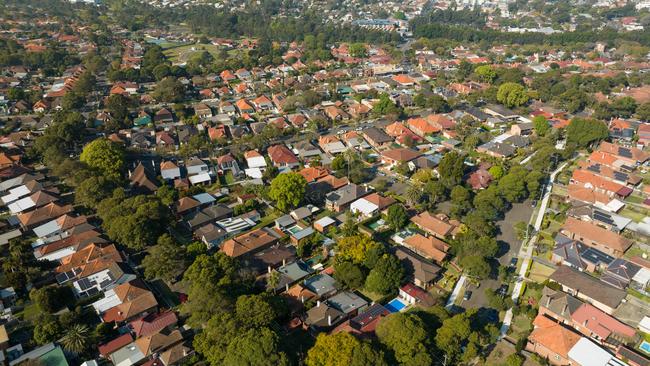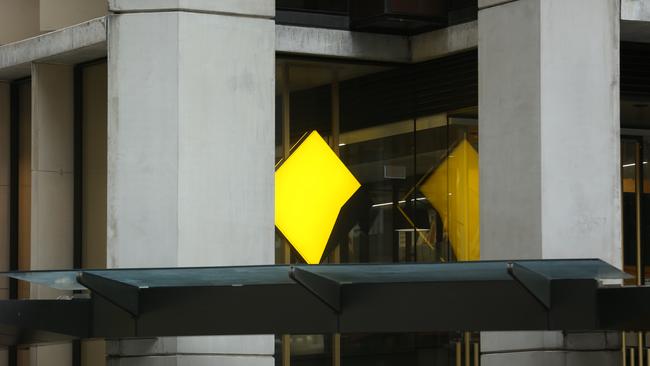CBA reveals $5.13bn cash profit but warns customers to not bank on a rate cut
Commonwealth Bank CEO Matt Comyn says a legion of homeowners would be disappointed if interest rates were not cut next week, but says rate relief is by no means a certainty.

Commonwealth Bank CEO Matt Comyn says a legion of homeowners would be disappointed if interest rates were not cut next week, but says rate relief is not certain amid intense pressure on the Reserve Bank.
After delivering a bumper $5.13bn first-half cash profit, beating analyst expectations, Mr Comyn said that, although people had showed resilience in the face of a surge in the cost of living, many were hopeful for relief from the RBA.
Mr Comyn, who has run Australia’s biggest bank since 2018, said it was clear that younger borrowers and Victorians were doing the worst of the bank’s customers.
He told The Australian it was obvious from the bank’s data that young savers were stretched, with 24 to 35-year-olds the only demographic tracked by the bank that had not seen a bounce back in their savings. The higher cost of food and essentials, coupled with surging rents, had squeezed young customers.
“Our younger customers have less financial resilience,” he said.
“The savings picture is slightly more positive, but also reflective where you started. Many households are still under real pressure.”
CBA’s result easily surpassed consensus estimates of a $5.06bn profit on the back of an improving situation for the bank’s bad borrowers.
Its shares closed at a record high of $165.98, up $3.82, or 2.4 per cent, for the day, giving the bank a market capitalisation of $277bn.
CBA is riding high on low rates of arrears and non-performing loans, with loan losses down 23 per cent on levels reported by the bank at the same time last year.
Troublesome and non-performing assets on CBA’s balance sheet were down over the half, to 0.95 per cent of assets.

But arrears did lift in the period, just above CBA’s historical average, to 0.66 per cent of the bank’s total loan book.
Victoria is CBA’s most troubled state, representing almost 48 per cent of its total non-performing, not well-secured home loans.
In comparison, NSW accounts for 26 per cent of the bank’s troubled book of bad loans.
But Mr Comyn said CBA was not pulling back from lending amid economic concerns.
“Our lending growth has again been strong and growing above system, which is a positive indicator about how we’re feeling about the medium-term prospects for Australian businesses,” he said.
Despite the challenging period, the bank was still focused on supporting customers.
“This enables us to support our customers, while lending to productive parts of the economy to stimulate economic growth,” Mr Comyn said.
The broader banking system is wary of intervention by the corporate regulator around hardships, after the Australian Securities & Investments Commission took aim at National Australia Bank and Westpac over their handling of hardship applications last year.
Citi analyst Brendan Sproules said CBA’s asset quality trends “somewhat painted a picture of a strengthening household”.
“Asset quality and loan growth were the key positives, but management indicated both will moderate as the economy slows,” Mr Sproules said.
Mr Comyn said CBA was witnessing a slowing economy, with cost pressures weighing on consumer spending and younger customers alike.
“Private sector growth is weak, immigration is starting to slow, and geopolitical uncertainties remain,” he said.
“However, underlying inflation is now moderating towards the target range, and we expect Australia will follow offshore economies with an easing cycle starting in 2025.”
The Reserve Bank is set to hand down its interest rate decision on February 18, in the wake of recent news that inflation growth has fallen to 2.4 per cent over 12 months.
Mr Comyn said if the RBA did not cut rates, people would be disappointed.
But he said the RBA should act independently on “what they determine to be the appropriate path”.
Mortgage lending
CBA’s accounts show the bank – Australia’s largest mortgage lender – is increasingly tilting towards housing investors, who now account for 42 per cent of all new home lending, up 5 per cent from 2023 levels.
Investors have also marched up CBA’s ranks to hit 30 per cent of total lending, up from 29 per cent in June last year. Owner-occupiers as a proportion of CBA’s total loan book have fallen 1 percentage point to 69 per cent of the total bank lending.

Mr Comyn said the lift in investor lending reflected the run-up in interest rates alongside a rise in house prices, which had shut many first-home buyers out of the market.
He said housing would “no doubt remain a dominant theme for many years”.
“I think it’s incredibly important to support young Australians in the housing market,” Mr Comyn said.
“We’ve got a long-term challenge making sure there’s more affordable housing.”
The company reported a 2.08 per cent net interest margin, the core measure of the bank’s lending profitability.
This was up one basis point on the levels reported by the bank in its 2024 second-half earnings and up two basis points from the same time last financial year.
Dividend payout
CBA declared an interim dividend of $2.25 a share, fully franked, topping analyst expectations of a $2.22-a-share dividend. This results in CBA paying out 73 per cent of its cash earnings.
The results come amid analyst hopes that CBA would look to hand back more cash to investors amid a sluggish $1bn buyback.
Only about $300m of CBA’s shares have been repurchased by the bank since the handout was started in August last year.
CBA has ploughed cash into buybacks in recent years, including sealing a $6bn program in 2021.
Morgan Stanley had even said that CBA could look to buy a further $1.5bn worth of shares.
CBA shares have been a major winner in the past year, lifting more than 40 per cent.
Wilson Asset Management portfolio manager Matthew Haupt said while CBA had delivered a “really high-quality result” it was an open question if the bank’s share price could be sustained. “There’s a disconnect between the share price and the fundamentals,” Mr Haupt said.
Despite this, WAM has added to its position in CBA, with Mr Haupt saying the fund bought more shares in the bank in the morning, despite more than halving its position during the run-up in the bank’s share price. “It’s been the wrong call, the share price keeps going up,” he said.






To join the conversation, please log in. Don't have an account? Register
Join the conversation, you are commenting as Logout